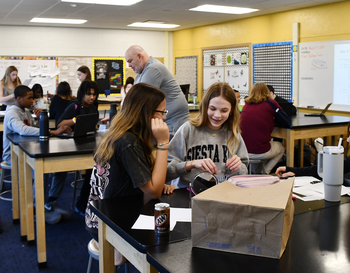Norup Students Reduce Heat in Dog Crates Through Thermal Energy Unit

Norup 7th graders finished a Thermal Energy Unit in science recently where they were tasked with creating a solution to cooling dog crates. Science teacher Brett Greer shared the scenario students worked from on this two-month unit, below. Students were challenged to construct, test, and improve potential solutions to this problem.
Scenario: The Humane Society knows the importance of maintaining a good quality of life for their shelter animals. If the shelter would ever need to take in additional animals for a similar reason, they are not prepared. This is especially true if the overcrowding occurs when it is hot outside. The shelter is not air conditioned and the outdoor space that they have is not currently suitable as a place of shelter. A group of area citizens is determined to develop a better solution for the future. Their plan involves placing extra dogs in individual crates outside of the main building. Since the shelter is most concerned about the heat, the dogs must be kept cool. The Society’s director has also stressed that any additional shelters should be easy to use, reliable, and inexpensive.
Over the two months of the unit, students learned about heat, temperature, thermal energy, the ways that mass and thermal energy are related, and the way thermal energy moves in our world. As students were learning these ideas, they would apply their new knowledge to create models of potential crate solutions. Students then got into groups to compare their ideas and to design, build and test their prototype designs for the Humane Society challenge. The primary objective was to have a crate that, under a heat lamp for 5-minutes, regularly kept the container at 3-degrees Celsius lower than the air around it.





